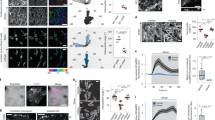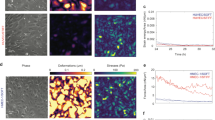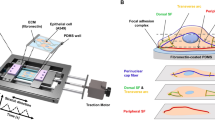Abstract
In this study, critical signaling pathway required for the stretch induced morphological changes of human umbilical endothelial cells (HUVECs) was investigated. Uni-axial cyclic stretch (1 Hz, 20% in length) of the cells cultured on an elastic silicon membrane induced a gradual morphological change in the cells from a polygonal shape to an elongated spindle-like shape whose long axis was aligned perpendicular to the stretch axis. We found that protein tyrosine phosphorylation of cellular proteins increased and peaked at 20 min in response to cyclic stretch. Either treatment of cells with gadolinium (Gd3+), a potent blocker for stretch-activated channels, or removal of extracellular Ca2+ blocked the tyrosine phosphorylation of the proteins, suggesting that stretch-activated (SA) ion channels regulated stretch specific tyrosine phosphorylation. The major phosphorylated proteins had molecular masses of approximately 120–135 kDa, and 70 kDa. Immunoprecipitation experiments revealed that paxillin, focal adhesion kinase (pp125FAK) and pp130CAS were included in the 70 kDa and 120–135 kDa bands, respectively. The morphological change was inhibited by herbimycin A and genistein, inhibitors of tyrosine kinases, suggesting that tyrosine phosphorylation was required for the morphological change. In addition, the kinase activation of pp125FAK was observed in response to cyclic stretch. Moreover, suppression of pp125FAK expression by the antisense phosphorothioate oligodeoxynucleotides (S-ODN) in HUVECs resulted in inhibition of tyrosine phosphorylation of paxillin and the stretch-dependent morphological changes. These results suggest that an activation of tyrosine kinase(s) by an increase in intracellular Ca2+ and pp125FAK play a critical role in the unique morphological change specifically observed in endothelial cells subjected to uni-axial cyclic stretch.
This is a preview of subscription content, access via your institution
Access options
Subscribe to this journal
Receive 50 print issues and online access
$259.00 per year
only $5.18 per issue
Buy this article
- Purchase on Springer Link
- Instant access to full article PDF
Prices may be subject to local taxes which are calculated during checkout
Similar content being viewed by others
Author information
Authors and Affiliations
Rights and permissions
About this article
Cite this article
Naruse, K., Yamada, T., Sai, XR. et al. Pp125FAK is required for stretch dependent morphological response of endothelial cells. Oncogene 17, 455–463 (1998). https://doi.org/10.1038/sj.onc.1201950
Received:
Revised:
Accepted:
Published:
Issue Date:
DOI: https://doi.org/10.1038/sj.onc.1201950



